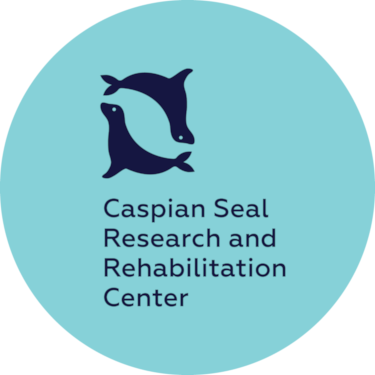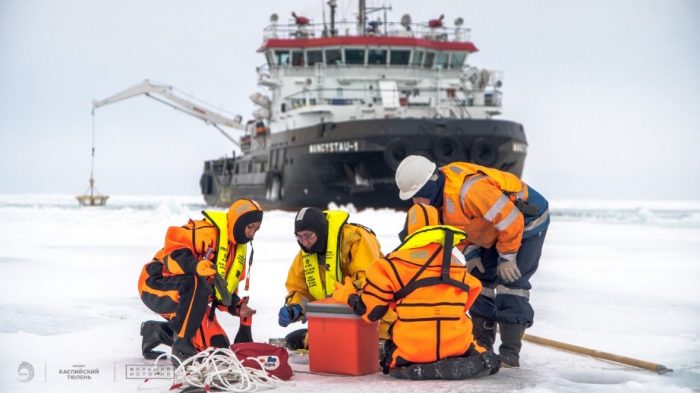Aselle I. Tasmagambetova1, Adylkhan D.Tovassarov1, Anne-Claire Bihan-Poudec2,Sharipa S. Bissariyeva1, Aslan B. Akberliyev1
1 Central Asian Institute for Ecological Research LLP, Almaty, Kazakhstan
2 Independent Center for investigation and Appraisal in organic Chemistry, Cuers, France
Abstract. This article is devoted to the determination of heavy metals and harmful organic compounds in sea water – the habitat of the Caspian seal. The group of the most common heavy metals, according to many authors, includes manganese, nickel, zinc, iron, cadmium, lead, copper and their salts, characterized by long-term preservation and accumulation in water, sediments and hydrobionts. The studies were conducted from February 7-12, 2017 on the route from the Kalamkas field through the islands of Kulaly to the village of Bautino. Water samples were taken 10-20 cm below the sea ice and surface level, each sample was taken in 2 replicates: one for the Kazakhstan laboratory in Almaty and one for the French independent laboratory. Water samples were analyzed for the content of 13 heavy metals such as – Co, Cu, Ti, Bi, Ag, V, Al, Be, Sb, Sn, Fe, Cr, Mo. It was established that in all water samples the content of vanadium exceeds the maximum permissible concentration (MPC) level by 1.5-7.4 times, beryllium – 140-445 times, antimony 13.2-17.2 times. The maximum concentrations of the V and Be contents were found in water samples taken at sampling points No. 1 and 2, and Sb – at points No. 1.6, 7.8. Cobalt, copper, iron and chromium were not detected in the samples presented. The content of other metals (Ti, Bi, Ag, Al, Sn, Mo) was significantly below the permissible levels or below the detection limits of the method. All samples of sea water are contaminated by several organic chemical pollutants, to various degrees and from different origins.
Data on the accumulation of petroleum hydrocarbons and heavy metals in the habitat of Caspian seals characterize the toxicological situation in the study region.
Key words: Caspian Sea, water sample, heavy metals, organic pollutants, chemical analysis.
Introduction
The problem of oil contamination of the Caspian Sea has become especially urgent and topical due to the forthcoming large-scale development of hydrocarbon sea offshore resources.
Based on the research results in 2003-2005 and 2008-2010, the concentration of heavy metals (copper, zinc, nickel, etc.) in sea water exceeds the specified limits. The maximum values were primarily observed in the southeastern shallow water area, the Kulalinsky threshold zone, and also in the region affected by the runoff of the Volga and the Ural Rivers [1-3].
As follows from the research results, the southeastern shallow-water zone of the Northern Caspian Sea with a slow water exchange; it is exposed to a rather intensive contamination with the development and exploration of oil and gas fields, such as Tengiz, Kalamkas, Karazhanbas, etc., is the site of accumulation of toxic compounds. Concentration of various contaminants (petroleum products and metals) in the area of the Kulalinsky threshold located in this sea area has to do with the peculiarities of the area where, according to some researchers [4-8], sedimentation and deposition of toxic suspended matter occurs under the conditions of convergence of the eastern and western parts of the Northern Caspian. Under the conditions of temperature change, reductive-oxidative situation in this zone, toxicants are recirculated, i.e. secondary pollution of the aquatic environment occurs. It is within the limits of this sea area that the mass mortality of seals and sturgeon fish is often observed over the last 10-15 years [9-12].
Along with hydrocarbons of various origin and polychlorinated biphenyls, the group of the most priority pollutants present in the waters of the Caspian Sea includes heavy metals (HM) – products of both natural origin and those that were brought in as components of industrial wastes with river flow, as well as associated with oil production.
To date, a huge number of works have been accumulated (Mur, Ramamurti, 1987; Zakharova, 2003; Khripunov, Katunin, Azarenko, 2010; Chuiko, Abdusamadov, 2013) devoted to the problem of water bodies’ contamination with heavy metals. According to many authors, the group of the most common heavy metals includes manganese, nickel, zinc, iron, cadmium, lead, copper and salts thereof, typified by long-term preservation and accumulation in water, bottom sediments and aquatic organisms.
The aim of the work is to determine metals and harmful organic substances in the water of the Kazakh part of the Northern Caspian.
Climatic Parameters
Wind Direction and Velocity. According to the long-term observations data in the northeastern part of the Kazakhstan sector of the Caspian Sea, the eastern wind direction is predominant (average of the year). In winter, east and south-east winds prevail. The strongest winds are most likely in March-April; the weakest are observed in July-August. The highest recorded (absolute maximum) wind velocities are as follows: at the nearest meteorological station of Kulaly Island – 45 m/s, in the Fort Shevchenko area – 40 m/s, in the vicinity of Peshnoy Island – 28 m/s.
Air Temperature and Humidity. In the coastal region, the annual temperature range can reach 67-70 °C. The maximum daily average variability is +2-14 °C. The daily maximum of air temperatures reaches +39 °C for Kulaly Island and +42 ºC for Fort-Shevchenko; the daily minimum is – 28 ºC for Kulaly Island and -25 ºC for Fort-Shevchenko.
Precipitation. The average annual amount of precipitation observed on the shore: Peshnoy Island – 165 mm, Fort-Shevchenko – 132 mm. With distance from the shore to the high seas, the amount of precipitation becomes lower (Kulaly Island – 126 mm). In annual precipitation, liquid precipitation prevails. Solid precipitation, such as snow, granular snow and snow grains are observed on the eastern coast of the Northern Caspian Sea from October-November to March-April. The average height of the snow cover does not exceed 10-20 cm [17].
Materials and methods
Sea water samples were taken during the expedition from February 7-12, 2017 for the survey of the northern part of the Caspian Sea on Mangystau-1 icebreaker on the route from the Kalamkas field through the islands of Kulala (the Seal Islands) to the village of Bautino (Fig. 1). The work was performed by the Central Asian Institute for Ecological Research (Almaty, Kazakhstan) in conjunction with the Independent Center for Research and Evaluation in the field of organic chemistry (Independent Center for Investigation and Appraisal in Organic Chemistry, Cuers, France).
All the water sample (WS) were collected from the 10th of February to the 12th February from the sea ice and surface level. Water samples were bottled in special 1 liter storage bottles. The water sampling; the requirements for the containers used, the volume, methods of preservation and the retention time were in compliance with the ISO 5667-3:2003. After sampling, water samples were placed into a cooler (+4°C) to maintain a constant temperature. All water samples were transported by plane to the laboratories of Almaty (Kazakhstan) and Cuers (France) (Fig. 2).

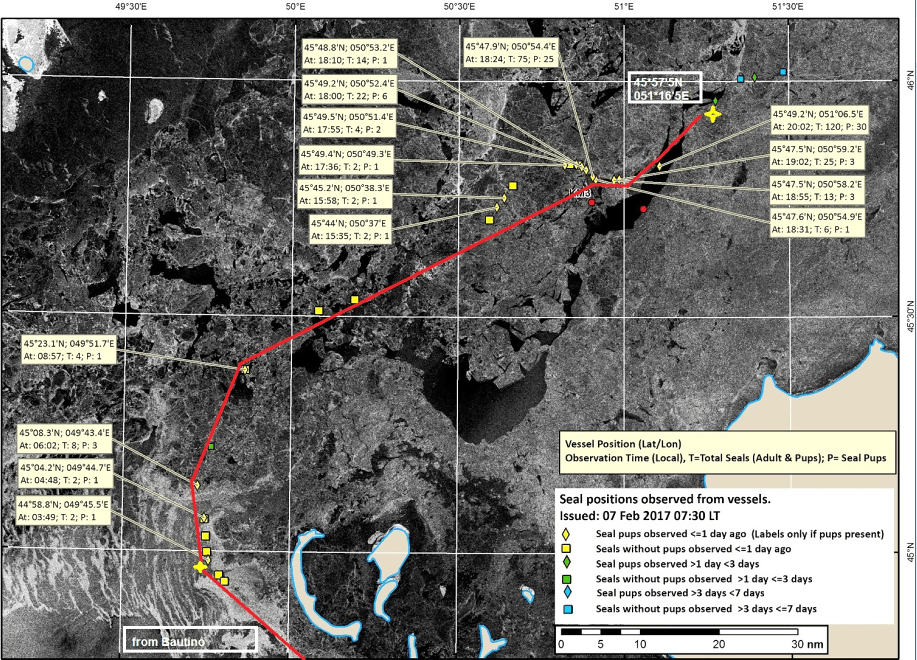

Water samples analyzes for metals were carried out at the environmental monitoring laboratory of “Central Asian Institute for Ecological Research” LLP in Almaty, and for biogenic elements and organic compounds – at the laboratory of the “Independent Center for Investigation and Appraisal in Organic Chemistry”, Cuers, France.
In the course of the work, the requirements of recognized international quality standards for the selection of containers for storage and transportation of selected samples, conditions for conservation, labeling, storage and transfer were met.
Sea water samples analysis (for 13 metals: Co, Cu, Ti, Bi, Ag, V, Al, Be, Sb, Sn, Fe, Cr, Mo) was carried out by the method of flame and electrothermal atomization using Duo55 B/240Z/UltrAASystem atomic absorption spectrophotometer. Pre-sample handling was carried out according to the method for identification of heavy metals in natural waters. The dosage of pre-handled sample was 20μl.
Screening method
The so-called systematic screening method implemented by the Analytika center (of the Independent French chemical laboratory) in is a state-of-the-art technique for establishing a complete list of chemical molecules present in a sample.
This technique is very different from the regulatory control practiced by accredited laboratories. Indeed, the controls carried out by these laboratories require them to know, before dosing, the precise identification of the molecules they are looking for. This is called “targeted control” or “targeted dosing”.
About targeted regulatory controls
Analysis of complex mixtures in environmental samples is an extremely difficult task. Since sample matrices in most cases are complex, traditionally ultra trace analytical methods were specifically developed for a certain type of sample and group of substances.
This traditional targeted approach gives good sensitivity and reliable identification and quantification of the target compounds, and has been used with success for several decades. However, this traditional approach has a significant drawback as it always will miss all compounds which were not selected at the start of the analyses. All unknowns or other untargeted substances even in high concentrations or with severe toxic potential, could be misses with this targeted method.
Targeted regulatory controls are limited to contaminants pre-defined by current regulations. This simplified procedure is sufficient to meet the needs of industry and the administration responsible for monitoring the regulatory compliance of industrial emissions.
This type of control remains ineffective for contaminants whose presence is not anticipated, not yet regulated, accidental or illegal. It is ineffective to anticipate the health effects of poly-exposure to carcinogenic, mutagenic or reprotoxic substances.
Non-target GC-MS screening method: a powerful tool for selecting environmental pollutants
Analytika’s systematic non-target screening tools reveal the chemical identity and content of the organic molecules and / or inorganic elements in our sample. By applying either gas or liquid chromatographic methods before introducing the analysis (compounds of interest) into mass spectrometer (GC-MS or LC-MS) scientists achieve a separation of the mass spectral signals which make the MS-information easier to understand and evaluate.
All the samples were prepared in duplicate and analyzed by different state-of-the-art techniques for non-target screening analysis. The raw data from instrumental analysis were treated with newly developed and very advanced software tools tailored to filter out as most as possible of relevant information.
Results and discussion
As a result of the chemical analysis, no cobalt, copper, iron or chromium were found in any of the water samples.
All water samples contained high concentration of heavy metals such as vanadium – from 0.255 mg/dm3 to 0.741mg/dm3 (up to 1.5-7.41 MPC), beryllium – from 0.028 mg/dm3 to 0.089 mg/dm3 (up to 140-445 MPC) and antimony – from 0.62 mg/ m3 to 0.86 mg/dm3 (up to 13.2-17.2 MPC). The maximum concentrations of V and Be were found in water samples taken at points No. 1 and 2, and Sb – at points No. 1, 6, 7, 8.
The content of other metals (Ti, Bi, Ag, Al, Sn, Mo) was significantly lower than the permissible levels or at the low range limits.
The pH value of sea water was within 7.9-8.1, which corresponds to an alkaline medium.
It was established that overall water pollution index (OWPI) in the studied water area with the depths of 6-7 m is characterized as “partially clean” (Information Bulletin on the environmental state of the Kazakh section of the Caspian Sea.) Issue 1 (50) 1st quarter of 2017. RSE “Kazhydromet”).
The results of chemical analysis of sea water for the content of heavy metals are shown in table 2.
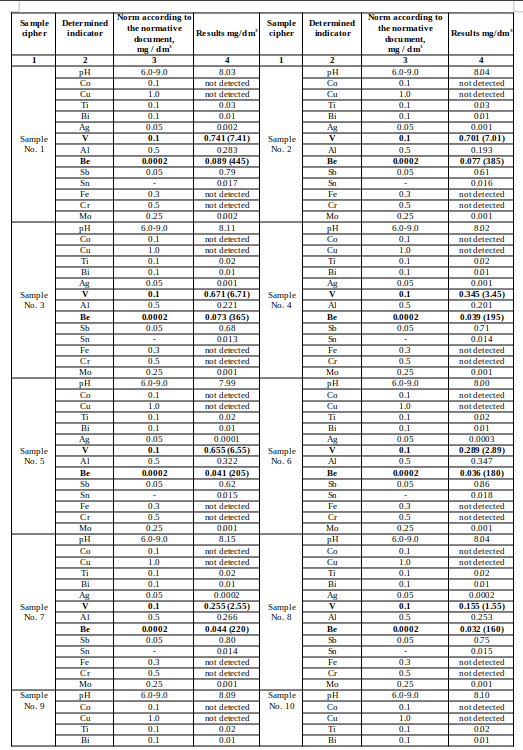

The following are the data on individual elements with the content exceeding MPC and their effect on living organisms.
Vanadium – its compounds are widely occurring in nature. In the Caspian Sea, it can get caught in the process oil production, while burning hydrocarbon fuel. In water, vanadium forms stable anionic complexes (V4O12) 4- and (V10O26) 6-. In the migration of vanadium, the role of its dissolved complex compounds with organic substances, especially with humic acids, is essential. The concentration of vanadium in natural waters is insignificant – hundredths and thousands of mg/l. In such quantities, vanadium does not have any significant effect on water quality. Obviously, this fact is the reason why neither the WHO, nor the USEPA, nor the EU, standardize the content of vanadium in water.
Lungs, bronchi, and the eyes are most affected by inhalation of vanadium-containing dust.
Beryllium is a metal that decomposes when it gets into water, highly toxic element. It can be present in the horizon and, as a result, can be contained in water obtained from soil wells. Beryllium has no taste, color or smell, thus, laboratory test is the only way to identify it. Beryllium was added to the list of pollutants of the Environmental Protection Agency (EPA) in 1994 under the law “Safe Drinking Water Act” (SDWA), therefore the information about its presence and effects is limited.
Beryllium has the property of forming compounds with other elements. These substances damage bones and lungs. In laboratory animals, such as rats and mice, prolonged exposure to beryllium compounds caused cancer. In terms of human body, there is very little evidence that beryllium, which is contained in drinking water, increases the risk of cancer [18, 19].
Antimony is a silvery-white metal with a bluish tinge, and it is toxic. It is a tracer element. Its content in the human body is 10-6% by weight. It is constantly present in living organisms, but it’s physiological and biochemical role is not clear. Antimony has an irritating and cumulative effect. It accumulates in the thyroid gland, depressing its function and causing endemic goiter. Antimony and its compounds are poisonous. Poisoning is possible when smelting concentrate of antimony ores and in the production of antimony alloys. Acute poisoning causes irritation of mucous membranes of the upper respiratory tract, eyes, and skin. Dermatitis, conjunctivitis, etc. can develop. Dust and antimony vapor cause nasal bleeding, antimony “metal fume fever”, pneumosclerosis, affect skin and disrupt sexual functions. Taste perception threshold in water is 0.5 mg/l. The lethal dose for an adult is 100mg, for children – 49 mg. For antimony aerosols MPC in the working zone air is 0.5 mg/m³, and 0.01 mg/m³ in the ambient air. MPC in soil is 4.5 mg/kg. In drinking water, antimony is classified as the 2nd hazard class with MPC of 0.005 mg/l, established according to the Limiting Harmful Index. In natural waters, the standard content is 0.05 mg/dm3.
In natural waters antimony compounds are in a dissolved and suspended state. Under reductive-oxidative conditions, typical of surface waters, the existence of both trivalent and pentavalent antimony is possible [18, 19].
Different elements reveal their peak values in various tissues of Caspian fish and seals: metals concentrate more in the liver, in caviar samples, and in muscle tissue.
Heavy metals are absorbed by phytoplankton, and then are transmitted along the food chain to more highly organized organisms. Disruption of ecological balance in water bodies creates a serious threat of significant deterioration of the ecological situation as a whole.
Based on the results of chemical analysis for organic compounds in water samples it is established that all samples are contaminated with organic compounds.
The results of chemical analysis on the content of organic compounds are shown on the Table 3 and Fig. 3 below.
| Sampling site | Amount of pollutants | Concentration, ng / l |
| WS 1 (seals breeding area) | 19 | 19 900 |
| WS 2 (seals breeding) | 14 | 37 821 |
| WS 3 (seals breeding) | 31 | 510 211 |
| WS 4 (seals breeding) | 22 | 66 266 |
| WS 5 (seals breeding area) | 7 | 9 481 |
| WS 6 (seals breeding area) | 18 | 58 772 |
| WS 7 (seals breeding area) | 23 | 92 199 |
| WS 8 (seals breeding area) | 20 | 66 273 |
| WS 9 (seals breeding area) | 13 | 30 024 |
| WS 10 (seals breeding area) | 17 | 68 919 |
Detected organic compounds:
2,4-dimethyl-1-heptene; trans-salvene; alpha.-pipene; heptane, 2,2,4,6,6-pentamethyl; undecane, 4,6-dimethyl; nonane, 2,6-dimethyl; nonane, 2,2,4,4,6,8,8-heptamethyl; c3-benzene; hexadecane, 2,6,10,14-tetramethyl; c3-benzene; decane, 2,5,6-trimethyl; decane, 2,6,7-trimethyl; 6-dodecene, (e); 1-decene, 4-methyl ; dodecane; 2,6-dimethyldecane; 1-decene, 3,4-dimethyl; dodecane; benzyl acetate; 2,6-dimethylbenzaldehyde; cyclooctane, methyl; hexadecane, 7,9-dimethyl; pentadecane, 5-methyl; octadecane, 6-methyl; tetradecane; phenol, 2,5-bis (1,1-dimethylethyl); hexadecane; diethyl phtalate; aucune similitude spectrale, 1-hexadecanol, 2-methyl; 1,2-benzenedicarboxylic acid, monobutyl ester; 2-hexyl-1-decanol; 1,2-benzenedicarboxylic acid, dipropyl ester.
It has been established that sea water samples are contaminated with several organic chemical pollutants to varying degrees and from different sources:
1 Residues of aliphatic hydrocarbons were detected and it was found that the main source of pollution is diesel fuel.
2 Industrial facilities are another major source of pollution. There were also other organic chemical pollutants found (and identified, with the exception of one major component), indicating water contamination from the industrial chemical process.
3 Residual matters of aromatic hydrocarbons were discovered, evidencing oil production-related operations there.
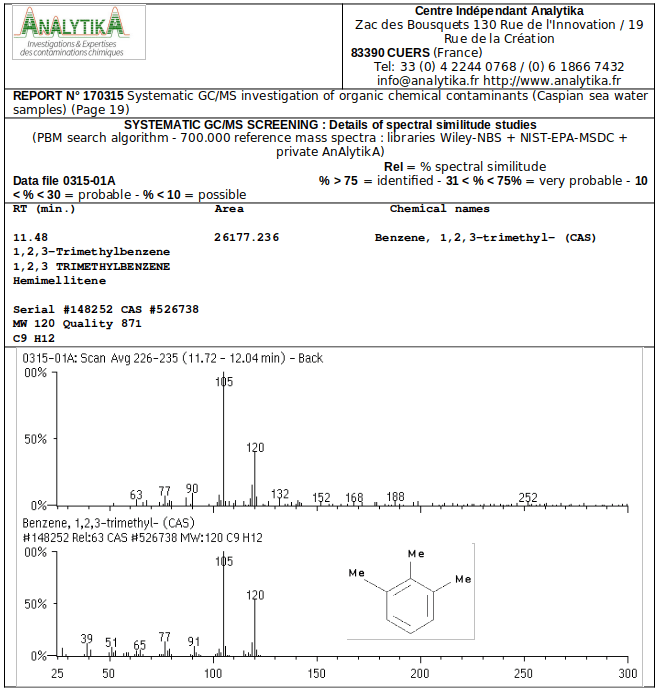
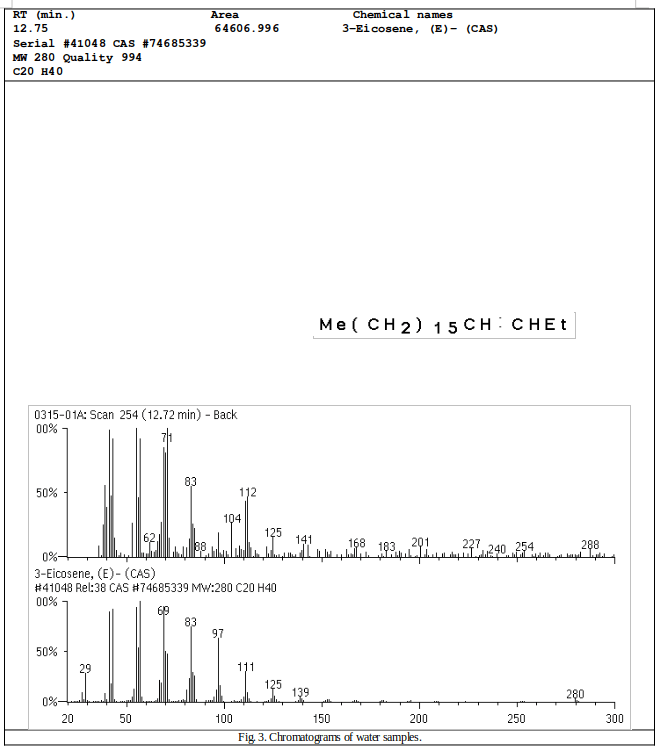
Conclusions
The conducted chemical analyzes of water samples indicate contamination of water samples in selected sites in the Caspian Sea, which negatively affects health not only of the Caspian seals, but also of other inhabitants of the Caspian Sea.
Taking into account the work carried out, it is necessary to conduct quarterly laboratory studies of natural environment and biota, in order to determine the degree of pollution.
In order to improve the habitat and preserve the biodiversity of marine animals, it is recommended:
– to organize systematic bioecological research across the entire water area of the Kazakh sector of the sea to create its own database and promptly address the issues related to protection of marine aquatic ecosystems and utilization of its bioresources;
– to establish strict analytical control over the inflow of pollutants into transboundary rivers of Ural and Kigash;
– for competent authorities of all the Caspian countries to take the necessary measures to eliminate pollution of the sea from flooded oil wells, production and domestic effluents of oil production facilities and from oil and drilling muds spilling from offshore installations and platforms.
Thus, data on the accumulation of petroleum hydrocarbons and heavy metals in the habitat of Caspian seals characterize the toxicological situation in the study region.
Acknowledgements
We thank all the expedition members and the crew of Mangystau-1 vessel; research assistants from the Laboratory of Central Asian Institute for Environmental Studies LLP (Almaty, Kazakhstan) and the Independent Center for investigation and Appraisal in organic Chemistry (Cuers, France).
References
[1] . Egorov S.N., Rylina O.N. and others. Ecological and toxicological characteristics of the lower reaches of the Volga River and the Caspian Sea // Fisheries research in the Caspian Sea (R&D findings for 2005) – Astrakhan, 2006. – p.p. 44-65.
[2]. Katunin D.N., Rylina O.N. Distribution of some pollutants in the aquatic environment of the Caspian Sea and levels of their accumulation in hydrobionts // Proceedings of the International Conference “Current state and ways to improve scientific research in the Caspian basin”. – Astrakhan, 2006. – p.p. 55-58.
[3]. Osipova L.A., Kargin S.A., Ilyazova F.Sh., Veremeenko O.V. Pollution of waters of the Volga-Caspian basin with heavy metals salts // Vestnik ASTU. 2008. – No. 3 (44). – p.p.126-131.
[4]. Amirgaliev N.A. The level of heavy metal contamination in the Kazakhstan water area of the Caspian Sea // Current state of bioresources of inland water bodies. – M.: Aquaros, 2011. – V. 1. – p.p. 16-21.
[5]. Tolosa I., Mora S., Sheikholeslami M.R, Villeneuve J., Bartocci J. Cattini C. 2004. Aliphatic and Aromatic Hydrocarbons in coastal Caspian Sea sediments // Mar. Pollut. Bull. vol. 48, pp. 44–60. DOI: https://doi.org/10.1016/S0025-326X(03)00255-8
[6]. Isbekov K.B., Amirgaliev N.A. Modern environmental problems and the state of bioresources of the Kazakhstan part of the Caspian Sea. Fisheries // Science News of Kazakhstan. 2012. № 1. – p.p. 106-113.
[7]. Ostrovskaya E.V., Asaeva K.I., Korshenko A.N., Samsonov D.P., Kolesnikova N.I., Kochetkov A.T., Pantyukhina A.G. Pollution of the bottom sediments of the northwestern part of the Caspian Sea by hydrocarbons and persistent organic pollutants // South of Russia: ecology, development. 2014, – No. 4. – p.p. 129-131.
[8]. Nemirovskaya I. Oil in the ocean (pollution and natural flows). M.: Scientific world, 2013. – 432 p.
[9]. Susan C. Wilson, Tariel M. Eybatov, Masao Amano, Paul D. Jepson, Simon J. Goodman. The Role of Canine Distemper Virus and Persistent Organic Pollutants in Mortality Patterns of Caspian Seals (Pusa caspica). PLoS ONE. 2014. 9 (7):| e99265.
[10]. Härkönen T., Harding K., Wilson S., Baimukanov M., Dmitrieva L., Svensson C.J., Goodman S.J. Collapse of a marine mammal species driven by human impacts. PLoS ONE 7 (9): e43130, 2012. http://dx.doi.org/10.1371/journal.pone.0043130.
[11]. Dmitrieva L., Härkönen T., Baimukanov M., Bignert A., Jüssi I., Jüssi M., Kasimbekov Y., Verevkin M., Vysotskiy V., Wilson S., Goodman S. Inter-year variation in pup production of Caspian seals (Pusa caspica) 2005-2012 determined from aerial surveys. Endangered Species Research, 2015. 28(3): 209-223.
[12]. Kuznetsov V.V. Environmental monitoring of the Caspian seal in the ice age in the waters of the Northern part of the Caspian sea // Мarine mammals of the Holarctic. Collection of proceedings. Vol.1. Moscow, 2015. P. 256-262.
[13]. Mur Dzh.V., Ramamurti S.M. Tyazhelye metally v prirodnykh vodakh. Kontrol’ i otsenka vliyaniya [Heavy metals in natural waters. Monitoring and assessment of impact]. Moscow: Mir. 1987. 288 р.
[14]. Zakharova N. Ah. The level of accumulation and influence of a number of toxicants on the status of the Caspian seal population // Thesis for the degree of candidate of biological Sciences, specialty 03.00.32 – biological resources. Astrakhan: FSUE “KaspNIRKh”, 2003. – 126 p.
[15]. Khripunov I.A., Katunin D.N., Azarenko A.V. Long-term changes in the granulometric composition and spatial distribution of bottom sediments of the Northern Caspian. Water resources. 2010. 37 (6). p.p. 709-716.
[16]. Chuiko E.V., Abdusamadov A.S. Peculiarities of heavy metals migration in the ecosystem of the Northern Caspian // Southern Russia: ecology, development. Geography and Geoecology. 2013. – No. 3. – p.p. 110-116.
[17]. Information bulletin on the state of the environment of the Kazakhstan part of the Caspian Sea. Issue 1 (50) 1st quarter of 2017, RSE “Kazhydromet”.
[18]. Collection of health-based exposure limits and methods for monitoring harmful substances in the environmental media. – M., 1991.
[19]. SanPiN. “Sanitary and epidemiological requirements for water sources, water intake points for household and drinking purposes, domestic and drinking water supply and places of cultural and domestic water use and safety of water bodies”. Order of the Minister of the National Economy of the Republic of Kazakhstan dated March 16, 2015. No. 209.
